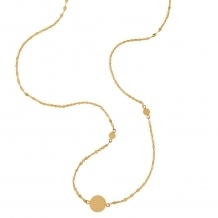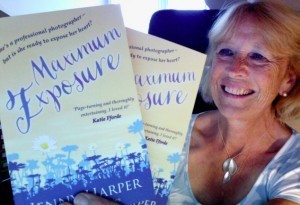L.A. Lewandowski's Blog: The Culture and Cuisine Club, page 5
April 19, 2015
Path of Life, Part One
April 10, 2015
Jewelry Care and Organization
March 22, 2015
This is a test post
March 15, 2015
Indulge in Leprechaun’s Irish Coffee
March 1, 2015
Stop—Don’t Return that Necklace!

Lana Trilogy Necklace
As you may know, I work in the jewelry and watch department at a luxury retailer. I really enjoy my job—the customers, the products, the opportunity to assist men and women with choosing the perfect gift or complementary piece to an outfit. I come home tired, but it is a good tired.
I have noticed a trend, a self-defeating behavior, and I must speak out. Many women complain that their husbands never buy them jewelry. Why do some men buy their wives jewelry and some do not? I propose one simple answer to this question. Let me describe an actual example of how we teach our husbands to not buy us the baubles we yearn for.
I look across the department and see a man with bed hair, wearing sweats and sneakers. He is looking at necklaces, and I greet him. After a few minutes of discussion, he chooses a $300 Lagos heart necklace. I box it for him and he departs, happy with his gift.
Two weeks later his wife comes into the department to return it. I greet her and tell her the care with which he chose the gift. She asks, “Was he cute when he was buying it?” I smile and say “yes, he was really particular in choosing something he thought you would like.” “Well,” she sniffs, “after twenty-one years of marriage he’s beginning to get it.” I ask, “Is there anything I can show you as a replacement?” She says “no, just put the money back on the credit card.”
How likely is it that her husband is going to buy her another piece of jewelry? Not very. This self-defeating behavior is, sadly, a situation I see frequently.
What should this woman have done to encourage her husband in his new (by her description) behavior? Wear the necklace!!! Give her husband a big kiss and a roll in the hay. Show appreciation that he ran to the store and thought of her. Don’t be a spoiled brat.
If she was really smart she should have asked for the receipt and gone to the store where the item was purchased. She should have found the salesperson who assisted her husband and said, “You know, this isn’t really my style, but I don’t want to hurt my husband’s feelings. Let me show you a few items I would love to have.” A partnership between the salesperson and the customer is forged, a list is made that the salesperson will keep, and a business card is given to the customer. The wife goes home wearing the original necklace and tells her husband that she happened to be in the store where he purchased the gift and met the salesperson. She thanked the salesperson for helping her sweetie choose the gift. She told the salesperson what she liked in the department for their upcoming anniversary, and of course it coordinates with the wonderful necklace he picked out for her. She gives him a kiss and thanks him again for thinking of her.
This is how you do it, my friends. Encourage your men with a little honey and be grateful for the presents they give you. Utilize the services of an experienced salesperson to assist you, and for heaven’s sake wear the necklace.
P.S. This doesn’t mean you can’t buy yourself a bauble or two. I will reserve that topic for future posts.
February 8, 2015
Writer, Interrupted

Iris Apfel
The one thing about life that always amazes me is how fast things can change. You think your career is developing successfully in one direction and all of a sudden you’re presented with an opportunity that you need to grab with enthusiasm. You thought you were busy before, tired before, but you are about to test your endurance and resilience. Again.
I had been looking for a part-time job for months to supplement the money I’ve been making on my book sales. My goal was to take the earnings and use it toward more promotion and to tune up my blog. I’ve had a job since I was thirteen years old. I wanted my own money again and Christmas was approaching.
Do you have any idea how difficult it is for a fifty-year-old woman to get a job? It is downright insulting that businesses aren’t interested in a mature, responsible woman with a great resume.
After sending out tons of resumes I was hired by Pandora to sell jewelry. Thankfully, I was also immediately presented with the opportunity to work for Nordstrom in the jewelry and watch department. I jumped at the chance.
I have always loved jewelry—what woman doesn’t—and the thought of working in a department full of beautiful products was exciting. I’ve read Vogue and Harper’s Bazaar since I was a teenager, and although I don’t dress in Valentino and Chanel I can tell you quite a lot about them.
The holiday season was an incredible challenge. I worked over two hundred hours, on my feet, in December. I learned how to size watches and talk to customers about jewelry. I was able to do one of my favorite things—help women choose the perfect earrings or necklace to go with a dress. Love that.
What has suffered in all of this delightful craziness is the current work in progress, the third mystery. There are only so many hours in a day. My manager asked if I would stay after Christmas and I agreed. So, now I must be super organized and incredibly stingy with my time. Gabbing on social media will be restricted to my days off. Yoga and tennis must fit in this limited free time as well. I need to carve out that hour early in the morning to write. I must push past the distractions and keep on with my pirates.
My message to all of you ladies who have reached a certain age is simple: You can do whatever you want at any age. A number is only a number, and we should never let anyone else limit our ability to reinvent ourselves. The New Year has just begun, and it is packed with possibilities for you and me. Go kick some butt.
November 12, 2014
The Tampa Tribune Features Author L.A. Lewandowski
 Wow! I am honored to be featured today by The Tampa Tribune. Journalist Joyce C. McKenzie interviews me regarding my upcoming seminar in the local library, Aspiring Authors 101. Here is the link: http://tbo.com/south-tampa/local-bestselling-author-to-host-seminar-20141112/
Wow! I am honored to be featured today by The Tampa Tribune. Journalist Joyce C. McKenzie interviews me regarding my upcoming seminar in the local library, Aspiring Authors 101. Here is the link: http://tbo.com/south-tampa/local-bestselling-author-to-host-seminar-20141112/
November 3, 2014
Authors Eat… Features Author Jenny Harper
 When I started the Authors Eat… feature I didn’t realize the pleasure I would derive from promoting the work of other writers. There are so many wonderful books written and published every day, books to suit the pickiest of readers. I am temporarily not in a book club, and this feature has encouraged me to research and read books I might never have known about.
When I started the Authors Eat… feature I didn’t realize the pleasure I would derive from promoting the work of other writers. There are so many wonderful books written and published every day, books to suit the pickiest of readers. I am temporarily not in a book club, and this feature has encouraged me to research and read books I might never have known about.
Our featured author this week hails from Scotland. Jenny writes charming books brimming with local custom and history. Her characters seem to embody the Scottish landscape, borrowing their quirks and tendencies from the drama of the terrain. So it is fitting that she has shared a recipe typically served at the yearly Burns Supper. And now in the authors own words…
Cullen Skink
As a pescivore (a vegetarian who eats fish), I am always on the lookout for tasty recipes. Cullen Skink is my all time favourite. It’s a traditional Scottish soup – the nearest US equivalent is chowder – and is incredibly tasty. It is frequently served at the beginning of a Burns Supper (the dinner traditionally held at the end of January every year to commemorate Scotland’s national poet, Robert Burns).
Cullen is a small town on the Moray coast, in north east Scotland. It’s a fishing town, and probably best known as the birthplace of this now traditional soup. ‘Skink’ is a Scot word meaning shin or knuckle of beef. From this it migrated to meaning soup, and thence, rather circuitously, just to meaning soup!
This soup can be a meal in itself. Leave it chunky, though you can mash down some of the potato so that it thickens nicely. You can also add cream to make it richer. It uses undyed smoked haddock – if you can’t get this, try using another undyed smoked fish. And serve with some warm and delicious crusty bread.
Perfect!
Ingredients:
30g butter
1 medium onion, coarsely chopped
2 medium potatoes, peeled and cut into 1cm cubes
300ml water
250g smoked haddock
250ml milk
salt and pepper to taste
2 tablespoons finely chopped parsley or chives
Method:
1. Melt butter in a saucepan over a low heat, then add the chopped onion and fry gently until soft and transparent.
2. Add potatoes pieces and water and bring to the boil. Simmer for 10-15 minutes.
3. In another pan, cover the haddock with the milk and cook gently for about five minutes until just cooked. Remove from the milk and flake into large pieces. Try to remove all the bones!
4. Add the milk and fish to the saucepan containing the potatoes and the rest of the ingredients and cook for another 5 minutes. Season with salt and pepper and sprinkle with chopped parsley.
Serve with crusty, warm bread and butter.
For more information about Jenny and her books please click on the following links.
http://jennyharperauthor.co.uk

https://www.facebook.com/authorjennyharper
Novel: FACE THE WIND AND FLY
US http://amzn.to/1o0DJeZ UK http://amzn.to/1xf3IJf
Novel: LOVING SUSIE
US http://amzn.to/1lBX1f5
UK http://amzn.to/1qfSorq
Novel: MAXIMUM EXPOSURE
US http://amzn.to/1vRUAZs
UK http://amzn.to/1vRUqRD
Blog: http://novelpointsofview.co.uk
October 5, 2014
Authors Eat… Features Author Mary Smith
 Have you ever wondered about Afghan cuisine? I have. The Culture and Cuisine Club is excited to feature a writer who has lived in Pakistan and Afghanistan. Mary Smith is an author, poet, journalist – and a businesswoman who worked in Afghanistan for an organization that helped raise funds for mother and childcare, and for those afflicted with leprosy. Mary has shared an insider’s peek into Afghan cuisine and a traditional recipe that I will be trying very soon. And now in the author’s own words…
Have you ever wondered about Afghan cuisine? I have. The Culture and Cuisine Club is excited to feature a writer who has lived in Pakistan and Afghanistan. Mary Smith is an author, poet, journalist – and a businesswoman who worked in Afghanistan for an organization that helped raise funds for mother and childcare, and for those afflicted with leprosy. Mary has shared an insider’s peek into Afghan cuisine and a traditional recipe that I will be trying very soon. And now in the author’s own words…
Living and working for many years in Afghanistan gave me the chance to sample many kinds of Afghan cuisine. Afghan kebabs are the best in the world. When I lived in the northern city of Mazar-i-Sharif it was our favourite take away on a Friday night. I still remember the tantalizing aroma of those lamb kebabs being cooked on street grills. Afghan sheep have what’s known as dumba – a fat tail – and pieces of this fat are interspersed with chunks of lamb on the skewers to add flavour. The kebabs were served inside round nan breads, which soaked up the delicious juices, then wrapped in newspaper. I found sheep testicle kebabs particularly tasty, possibly because I’d eaten them before I knew what the succulent softness was.
Afghans love giving dinner parties – or mehmani. The dishes are spread on a cloth – dastakhan – on the floor and guests sit cross-legged around it. Anyone serving less than seven dishes is considered a skinflint and, believe me, word would have spread before morning. There would be chicken or meat (usually goat – and don’t be surprised if you meet your dinner when it is brought in to be blessed by the diners before despatch) in rich gravy, kabuli rice topped with raisins and strips of carrots glistening with oil, yoghurt, one or two vegetable dishes and sweet dishes such as firni made with milk and corn flour and heavily sweetened. For cooking at home in the city I had an imported Chinese cooker with three rings, fed by a gas bottle.
Chicken defeated me for ages. No matter what method, including using a pressure cooker, my chicken was always like boot leather. Afghan chickens are free range, clocking up the miles to find food so there’s very little fat. Plus, no one eats a chicken until it has become an old hen and stopped laying eggs. I found the solution in an international newspaper – wine. Not cooking the bird in wine, but tenderising it from the inside out. Like everyone else we bought our chickens live so during their last few days on earth we fed them well and gave them lots of red wine to drink brought across the border from Uzbekistan. It worked like magic and I could finally impress my Afghan diner guests with succulent chicken, albeit with a slightly pinkish tinge. And that’s why the chickens in my non-fiction book are drunk.
Of course it wasn’t all banquets and mostly I ate everyday food including a meat-based soup into which we broke our bread. Once it was mushy, we used another piece of bread as a spoon. I enjoyed simple rice with lentils or red kidney beans and ash – pasta (Afghanistan was on the Silk Route so benefited from fusion cuisine long before it was fashionable) served with quroot, a rock-hard sour cheese made from buttermilk which is re-hydrated into a sauce. Tastes a lot better than it sounds. Little leek-filled dumplings are delicious as is mantu, a labour-intensive dish of steamed dumplings filled with minced beef and onions, topped with a yogurt sauce. One of my favourite dishes – perhaps because it is easily reproduced at home – is banjan-sia borani. This is egg-plant (aubergine) slices fried and served with cooked tomatoes, topped with a sour cream and yoghurt garlicky sauce and dried mint.
Banjan-sia Borani
Ingredients:
4 Aubergines/Eggplants – the nice, long purple ones
Oil (I use sunflower)
Salt and black pepper
1 tsp paprika
4 tomatoes, sliced
1 onion finely chopped
8 medium cloves garlic, minced
1 cup thick yogurt
1 cup sour cream
Method:
Slice the eggplants lengthwise into thick slices. Fry in the oil until golden and still slightly firm in the middle. Drain on kitchen paper. Fry the onions with one of the minced cloves of garlic until soft then add the sliced tomatoes and cook until the tomatoes are soft. Add a cup of water; bring to the boil then leave to simmer until the sauce thickens. Add salt and pepper to taste. Put the eggplant into the sauce to warm through. Mix the yoghurt and sour cream together with the minced garlic, 1 tsp salt and dried mint. Put half the yoghurt sauce on a serving platter, top with the eggplant and tomato sauce the pour the rest of the yoghurt sauce on top. Sprinkle with paprika. Serve with fresh nan bread.
Mary’s Blog: http://www.marysmith.co.uk/index.asp
Mary’s Amazon author page: http://www.amazon.com/Mary-Smith/e/B001KCD4P0/
September 27, 2014
Authors Eat… Features Romance Author Jackie Weger
 Who doesn’t like a little romance? The Culture and Cuisine Club believes without romance the world would be a pretty dull place. We are excited to share with you a recipe from world traveler and prolific romance author Jackie Weger. Jackie is not only successful in her own right, but has made it her business to assist other writers in marketing and promoting their work. She believes in paying it forward. And now in the author’s own words…
Who doesn’t like a little romance? The Culture and Cuisine Club believes without romance the world would be a pretty dull place. We are excited to share with you a recipe from world traveler and prolific romance author Jackie Weger. Jackie is not only successful in her own right, but has made it her business to assist other writers in marketing and promoting their work. She believes in paying it forward. And now in the author’s own words…
How many lark’s tongues make a meal?
I have eaten strange foods. I once was the guest of a family who lived on the top of a mountain in a dry Pacific rainforest. No electricity, no ovens in the thatched-roofed kitchen—all foods prepared fresh and on a native stove built of river rock and sand. I was served the choicest part of the meat. Boiled chicken head. Eyes intact. Beak intact. Little tongue sticking out. Yes, I ate it. One does not offend when one is the guest of honor. I have since learned to make chicken feet soup. Do not forget to cut off the nails. It is wonderful and tasty. The feet do startle guests when they find them in the bottom of the bowl.
On another note of cuisine and another continent: Many French people speak English if one is on a tourist route. However, off the tourist grid where I prefer to travel, you need to know a little French. Thank goodness, I had spent many a weekend and Mardi Gras in New Orleans, which gave me a heads up to order un café au lait. Every server in every tiny village or sidewalk café or bistro gets it—in spite of my Southern drawl.
You cannot get through Paris and its environs without sampling the foods. You can eat grand by shopping in open-air vegetable and fruit markets, the tiny bakeries and chocolatiers or street vendors—which I did. Lunch was often in museum cafés and I did not go out for supper. An apple, some grapes and a small loaf of bread or a meat pastry and perhaps some cheese sufficed as I soaked my sore tourist’s feet and hung out the tiny hotel window watching the locals on the narrow, cobbled streets—an entertainment all its own.
Nevertheless, late one night I did get hungry. I somehow lost my goody bag of fruits and cheese and followed a gaggle of natives to an outdoor café. Tables were tiny and elbow-to-elbow. My dining companions were an archeologist from the UK, on his way to another adventure in Egypt and his long-suffering wife—on her way back to the UK to hold down the fort, raise the kids and earn money to support her adventurer, certainly the worst half, on his escapades. The chat up was interesting and a writer never knows where we will find a character to make an on page visit, so I didn’t glance too much at the menu, and ordered une salade de poulet (chicken salad), a glass of house wine.
I do not like to order tossed green salad in foreign countries because it never comes with dressing, except perhaps vinegar and oil. I like blue cheese. However, I soon learned un salade de poulet de France is not chicken salad USA.
The salad came and it was monstrous. In a bowl. An entrée served with a quarter cup pitcher of vinegar. Not. The pitcher was vinegar sweetened with local honey—served hot. The salad had fresh greens, boiled, sliced eggs, crispy slices of chicken light and dark, grand slices of vine-ripened cantaloupe and tomatoes dotted with cracked pepper. Who knew? The hot honey watered with vinegar enhanced the flavor of every tidbit in the salad. And then a surprise. At the very bottom of the bowl, les pommes de terre sautées(diced and crisp fried potatoes)—still warm and gently flavored with honey-vinegar.
It was to this day the best salad I have ever tasted and so easy to duplicate. The salad was not salted and I did not add a grain.
Here’s what you need:
Large wooden bowl.
Salad greens—your choice.
Two boiled eggs shelled and quartered.
Fresh tomato—quartered
Fresh cantaloupe, four generous slices.
Sliced cooked chicken white and dark. Sauté in olive oil.
Potato diced—boiled for two or three minutes—drain and sauté in olive oil until tender. Don’t worry if not browned.
¼ cup of white vinegar.
¼-cup honey.
While ‘building’ the salad allow honey-vinegar mixture to warm over low heat. Do not boil.
Here is what you do:
Layer the bottom of the bowl with a large lettuce leaf. A must have to catch any honey mixture that settles.
Put a couple of heaping spoonfuls of potato in the middle of the leaf.
Add salad greens to cover potatoes. Add chicken slices. Add tomato quarters. Add egg quarters. Add cantaloupe slices. Sprinkle with cracked pepper.
Place hot honey-vinegar mixture in a cruet ready to pour over salad once served.
The French serve every meal with bread. American crackers of any description, however fancy, will not do for une salade de poulet.
A warm French loaf, sliced or whole makes the meal. Do not use butter because it greases the palate and you want your taste buds open to receive the wonderful, sensuous and unexpected mingling of flavors.
Marie Antoinette could have easily dined on the same salad. Along with lark’s tongues—a favorite of royalty on all continents.
Did you know that honey is the only food in our universe that does not go bad? It has shelf life of a thousand years and more!
I will be making this salad in the near future for sure.
To learn more about Jackie and her books visit her blog http://jackieweger.com/
Her Amazon author page: http://www.amazon.com/Jackie-Weger/e/B001JS2M62/
E Novel Authors at Work blog: http://enovelauthorsatwork.com/
The Culture and Cuisine Club
- L.A. Lewandowski's profile
- 102 followers



